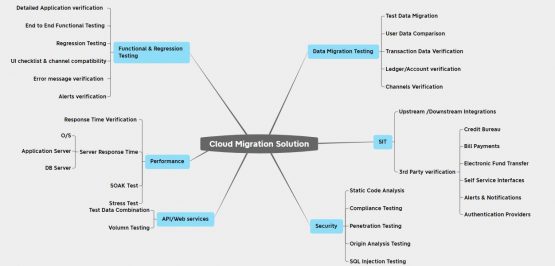The impact of Cloud Migration Assurance on legacy banking applications
Legacy banking systems are decades behind as digital advancements continue to disrupt the sector. Cloud computing has long since crossed the line from experimental to mainstream. The next question is how quickly companies should adopt and convert to cloud computing.
The developments in adjacent technology markets include Digitalization, where 28% of new enterprise IT spend, and >60% of annual IT spend, will be made on cloud-based offerings. Also, it is estimated that 40% of existing application software will be moved to the cloud by 2022.
Containerization will become the default cloud API framework, and multi-cloud architectures will adopt open API stacks for flexible workload shifts. Cloud data centres are processing a large part of these workloads using hyper-scale data processing. Cloud-native AI platforms will fulfil the fast-emerging need for real-time high-sensitivity scientific analysis.
Drivers for Cloud Migration
There are multiple technologies as well as business drivers which are accelerating the adoption of the cloud.
- Cloud-based infrastructure gives superior cost savings and flexibility in terms of scalability on demand. This cost advantage has dramatically enabled the startups to compete on par with larger incumbent players, as is evident in a large number of neo banks.
- Cloud-based SaaS gives the potential for better integration with Fintech offerings and helps leverage technology better, enabling the launching of newer service lines and superior customer experience.
- As the cloud offerings mature, they offer assured service standards, giving the end users the comfort to migrate.
- Once effectively migrated and configured, a cloud-based ecosystem might be more resilient and offer better disaster recovery outcomes.
Cloud Adoption Challenges for Legacy Banking Applications
While the benefits of cloud migration are increasingly becoming evident in one way or another, migration to a cloud-based infrastructure and operational model comes with its own set of challenges that need to be addressed effectively to ensure the success of the migration.
Some of these can be categorized as,
System availability: While a transition from an on-premise to a cloud-based model is done, it is essential to ensure there is no impact on the customer experience regarding availability and performance, especially in the case of business-critical applications like Core Banking applications.
Data Consistency: Data is the most sensitive element of a BFSI ecosystem, and a major transformational program such as cloud migration can get quite challenging in this aspect. The various data sets such as product data, account data, and historical transactional data need to be carefully backed up and migrated onto the new cloud infrastructure. This whole process should not open any vulnerabilities in terms of access and obfuscation.
Security: In terms of the financial risks involved, Security ranks high for any BFS System. Compliance with the mandated security standards is a strict requirement. The system should also be safeguarded from any external attacks and insecure APIs.
Technological incompatibilities: Cloud migration can pose significant integration challenges with the peripheral applications and any co-existing legacy infrastructure.
Test imperatives and the overall cloud migration assurance approach
There is a compelling need for a testing service provider to validate activities across the entire value chain of the cloud migration journey. Stringent and diligent assurance is critical across the whole value chain of the cloud migration journey to ensure success. The validations have to be done across the technological layers of,
Infrastructure:
- Modelling the infrastructure basis, the recommended design architecture and environment blueprint
- Validating the necessary integrations for the correct configuration settings
- Testing the integrated environment for checkpoints of desired scalability, resiliency, and responsiveness
- Configuration testing around servers, storage, and database
- Testing validations for multi-tenant systems
Data:
- Validating all database components are migrated
- Testing the data flow as per the requirements
- Testing of data security at rest, in use and during transit
- Enforcing checkpoints for the sensitivity of the data towards stakeholders through data privacy testing
- Assessing security vulnerabilities in the new environment which may compromise confidentiality
Application:
- Testing the functionalities along with the upgraded features
- Ensuring validation of the end-to-end business workflows
- Checking whether the cloud supports the application’s architecture
- Ensuring the integration of workloads and business processes after their successful migration
- Validating the regulatory and compliance requirements
A few more test imperatives that are good to consider will be,
- Testing compatibility when there are frequent build and environment changes can be resolved by maintaining smart checklists that ensure thorough verification despite multiple changes.
- Testing 3rd party interfaces on different environments. This can be achieved through an effective Impact Analysis and Risk-based test categorization and focused Functional Automation
- Volume Testing requirement to validate an exhaustive list of test data combinations by web services automation.
The below picture provides a comprehensive view of the various tests that go into a validation program of cloud migration. However, just as no two cloud migration initiatives are the same, the cloud migration assurance programs should be tailored to the overall approach and dynamics of the migration initiative itself.
Core Banking cloud migration: Core Testing Areas
Conclusion
Pre-migration advisory, migration assurance, and post-migration validation are all part of Cigniti’s Cloud Migration Assurance Services. The Cloud Assurance Platform (CLAP) is a complete testing platform developed on top of our AI-enabled quality engineering platform, BlueSwan, to deliver testing services throughout the migration lifecycle.
We create value-added solutions with our Cloud assurance solution and deep BFSI domain knowledge in understanding business processes and requirements throughout the industry. Our primary technical differentiators include Cigniti’s CLAP Platform, automated, reusable test scripts, and automated test strategy.
Cigniti’s Cloud Migration Assurance services can help you get the best out of your cloud transition for legacy banking applications. Schedule a discussion now.






Leave a Reply